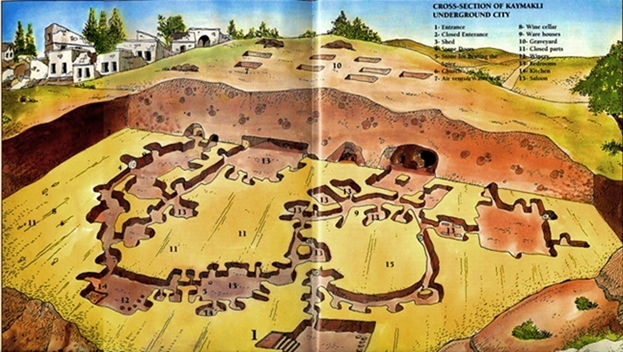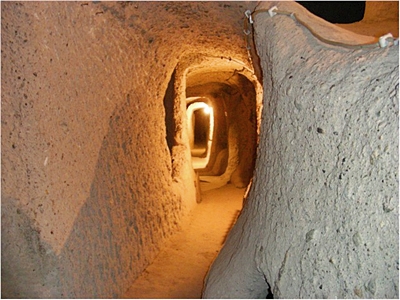KAYMAKLI UNDERGROUND CITY
Underground Cities? These troglodyte cave-cities were excavated as early as Hittite times, and expanded over the centuries as various marauding armies traversed Central Anatolia in search of captives and plunder. There are 36 underground cities in Cappadocia and the widest one is Kaymakli underground city, while the deepest is the Derinkuyu Underground City.
Kaymakli underground city is built under the hill known as the Citadel of Kaymakli and was opened to visitors in 1964. The people of Kaymakli (Enegup in Greek) village have constructed their houses around nearly one hundred tunnels of the underground city. The inhabitants of the region still use the most convenient places in the tunnels as cellars, storage areas and stables, which they access through their courtyards. The Kaymakli Underground City has low, narrow and sloping passages. While the underground city consists of 8 floors below ground, only 4 of them are open to the public today, in which the spaces are organized around ventilation shafts.
 The first floor of the underground city is the stable. The small size of this area suggests that there could be other stables in sections that have not yet been opened. The passage to the left of the stable contains a millstone door and leads into the church. To the right of the corridor are rooms hollowed out as living areas.
The first floor of the underground city is the stable. The small size of this area suggests that there could be other stables in sections that have not yet been opened. The passage to the left of the stable contains a millstone door and leads into the church. To the right of the corridor are rooms hollowed out as living areas.
The church on the 2nd floor has a single nave and two apses. In front of the apses is an altar, and on the sides are seating platforms. There are also some living areas on this floor.
The most important areas of the underground city are on the 3rd floor. Besides numerous storage places, wineries and kitchen, the block of andesite with relief-texture found on this floor is very interesting. Recent research has proved that this stone was used as a melting pot for copper. The stone was not brought here from outside but was part of the andesite layer unearthened while hollowing. To be able to use it as a melting pot, 57 holes were carved on the surface of the stone. The copper ore, about 10 cm in length, would be put into one of those holes and would be hammered using a hard piece of rock. This technique has been known since the Prehistoric Periods.
 The copper brought to the Kaymakli Underground City was probably dug from a quarry between Aksaray and Nevsehir. (The same quarry was also used by the people of Asilikhoyuk, the oldest known settlement in Cappadocia Region.)
The copper brought to the Kaymakli Underground City was probably dug from a quarry between Aksaray and Nevsehir. (The same quarry was also used by the people of Asilikhoyuk, the oldest known settlement in Cappadocia Region.)
The fact that there are a lot of storage rooms and places to put earthenware jars in the wineries on the 4th floor indicates that the people living in this underground city were economically stable. The ventilation shaft can also be seen from the 4th floor. It is a vertical well and passes all floors down like on the elevator in an apartment. The depth of the ventilation shaft is about 80 meters in total.
Even though the whole city has not been completely opened, and since only 4 floors have been uncovered, it is certain that Kaymakli is one of the largest underground settlements in the region. It is accepted as the widest underground city of Cappadocia, among the explored ones. The number of the storage rooms in such a small area supports the idea that a great number of people resided here. Archeologists think that this could have been up to 3500 people.
At Turkish Heritage Travel, we organize private tours to Kaymakli Underground City. The rate of the tour is 70 Euro per person based on minimum 2 people including transfer to/from your hotel in Goreme, entrance fee and professional guide. The tour takes around 2 hours. It is also included in our group full day Cappadocia Tours.
Please send us an email to get further information and book tours.
PLACES TO VISIT IN CAPPADOCIA
There are so many fascinating things to see in Cappadocia that you could spend a lifetime here and still discover new places. The main 'must-see' attractions are the two large open-air museums and the best of the underground cities. However, there are also many small, all-but-forgotten rock-cut churches and monasteries, splendid hiking trails, several spectacular caravanserais and many dramatic rock formations well worth going out of your way to visit.- Goreme Open Air Museum: cave churches with frescoes
- Zelve Open Air Museum: an empty cave town with churches
- Kaymakli Underground City: the largest underground city
- Derinkuyu Underground City: the deepest underground city
- Ihlara Valley: the deepest gorge of Anatolia
- Uchisar: Roman rock-cut castle
- Ortahisar: Roman rock-cut castle
- Avanos: center of pottery since the Hittites
- Pasabag: mushroom-shaped fairy chimneys, monks valley
- Devrent: animal-shaped fairy chimneys, imagination valley
- Hacibektas: center of Bektasi sect of Islam
- Gulsehir: first settlements in Cappadocia
- Forgotten Cave Churches: churches located in the valleys
- Caravanserais: 13th century hotels on the silk road
